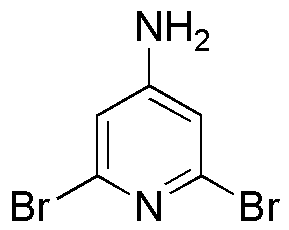4-Amino-2,6-dibromopyridine is widely utilized in research focused on:
- Synthesis of Pharmaceuticals: This compound serves as an important intermediate in the synthesis of various pharmaceuticals, particularly in the development of anti-cancer and anti-inflammatory drugs.
- Agricultural Chemicals: It is used in the formulation of agrochemicals, including herbicides and fungicides, helping to improve crop yield and protect against pests.
- Material Science: The compound is employed in the creation of specialty polymers and materials, enhancing properties such as thermal stability and chemical resistance.
- Research and Development: In academic and industrial laboratories, it is a valuable reagent for studying reaction mechanisms and developing new chemical processes.
- Electronics: It finds application in the production of electronic materials, contributing to the development of advanced semiconductors and conductive polymers.
General Information
Properties
Safety and Regulations
Applications
4-Amino-2,6-dibromopyridine is widely utilized in research focused on:
- Synthesis of Pharmaceuticals: This compound serves as an important intermediate in the synthesis of various pharmaceuticals, particularly in the development of anti-cancer and anti-inflammatory drugs.
- Agricultural Chemicals: It is used in the formulation of agrochemicals, including herbicides and fungicides, helping to improve crop yield and protect against pests.
- Material Science: The compound is employed in the creation of specialty polymers and materials, enhancing properties such as thermal stability and chemical resistance.
- Research and Development: In academic and industrial laboratories, it is a valuable reagent for studying reaction mechanisms and developing new chemical processes.
- Electronics: It finds application in the production of electronic materials, contributing to the development of advanced semiconductors and conductive polymers.
Documents
Safety Data Sheets (SDS)
The SDS provides comprehensive safety information on handling, storage, and disposal of the product.
Product Specification (PS)
The PS provides a comprehensive breakdown of the product’s properties, including chemical composition, physical state, purity, and storage requirements. It also details acceptable quality ranges and the product's intended applications.
Certificates of Analysis (COA)
Search for Certificates of Analysis (COA) by entering the products Lot Number. Lot and Batch Numbers can be found on a product’s label following the words ‘Lot’ or ‘Batch’.
*Catalog Number
*Lot Number
Certificates Of Origin (COO)
This COO confirms the country where the product was manufactured, and also details the materials and components used in it and whether it is derived from natural, synthetic, or other specific sources. This certificate may be required for customs, trade, and regulatory compliance.
*Catalog Number
*Lot Number
Safety Data Sheets (SDS)
The SDS provides comprehensive safety information on handling, storage, and disposal of the product.
DownloadProduct Specification (PS)
The PS provides a comprehensive breakdown of the product’s properties, including chemical composition, physical state, purity, and storage requirements. It also details acceptable quality ranges and the product's intended applications.
DownloadCertificates of Analysis (COA)
Search for Certificates of Analysis (COA) by entering the products Lot Number. Lot and Batch Numbers can be found on a product’s label following the words ‘Lot’ or ‘Batch’.
*Catalog Number
*Lot Number
Certificates Of Origin (COO)
This COO confirms the country where the product was manufactured, and also details the materials and components used in it and whether it is derived from natural, synthetic, or other specific sources. This certificate may be required for customs, trade, and regulatory compliance.


